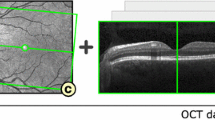Abstract
The majority of visual impairments are related to retinal disorders. Therefore, techniques useful for early detection of retinal anomalies are of great interest for diagnosis and treatment of related pathologies. Optical Coherence Tomography (OCT) is a non-invasive technique that is becoming increasingly important in the analysis of human retina. This technique produces sections of a three dimensional reflectance map, which are pseudo-images of the retinal structure. In these pseudo-images, early pathologies may produce local modifications of reflectance, which visually, appear as blots. Consequently, automatic procedures for detection of such blots may be of help in the diagnosis of many retinal diseases. Due to the complexity of the measurement technique and of the retinal structure, the pseudo-images produced by OCT can be modeled as 2D random signals: the above pathological blots correspond to sudden changes in the distribution of such OCT signals. In this work, we performed a statistical analysis of retinal OCT data. We found that the so-called stretched-exponential distribution, a two-parameter probability density function, provides a model that describes the data in a satisfactory way. In addition, we analyzed spatial-reflectance interdependence by studying the autocorrelation function; this analysis showed a significant correlation between contiguous pixels about 5 μm apart. We then developed a procedure to obtain the maximum-likelihood estimate of distribution parameters along the retinal pseudo-image. With this procedure, we analyzed their spatial dependence both along and across retinal layers. We observed that along suitable thin layers, the two parameters were statistically constant. By exploiting this result, a statistical procedure was developed for automatic detection of parameter variations due to retinal pathological blots. Some first results are reported for detection of diabetic retinopathy.
Similar content being viewed by others
References
Castano, P. Donato, R.F., et al.: Anatomia dell’Uomo, 2nd edn. Edi-Ermes (2006)
Barlow, R.E., Proschan, F.: Distributions with monotone failure rate. In: Serra, A., Barlow R.E. (eds.) Theory of Reliability, Società Italiana di Fisica XCIV Corso, Varenna (1984). North Holland (1986)
Berberan-Santos, M.N., Bodunov, E.N., Valeur, B.: Mathematical functions for the analysis of the luminescence decays with underlying distributions 1. Kohlrausch decay function (stretched exponential). Chem. Phys. 315, 171–182 (2005)
Costa, R.A., Skaf, M., Melo, L.A.S. Jr., et al.: Retinal assessment using optical coherence tomography. Prog. Retin. Eye Res. 25(3), 325–353 (2006)
Giannini, D.: Analisi Statistica dei dati di tomografia a coerenza ottica: applicazione nella diagnosi delle retinopatie diabetiche (tesi di laurea). Università di Roma La Sapienza (2008)
Grzywacz, N.M., De Juan, J., Ferrone, C., Giannini, D., Huang, D., Koch, G., et al.: Statistics of optical coherence tomography data from human retina. IEEE Trans. Med. Imag. (2010). doi:10.1109/TMI.2009.2038375
Langberg, N.A., Leon, R.V., Lynch, J., Proschan, F.: The extreme points of the set of decreasing failure rate distributions. Z. Wahrscheinlichkeitstheor. Verw. Geb. 57, 303–310 (1981)
Radhakrishnan, S., Lass, J., Huang, D., Cooper, K.: Emerging clinical applications of optical coherence tomography. Optics Photonics News 13, 36–41 (2002)
Robbins, S.L., Cotran, R.S.: Pathological Basis of Disease, 7th edn. Elsevier, Amsterdam (2006)
Kim, B.Y., Smith, S.D., Kaiser, P.K.: Optical coherence tomographic patterns of diabetic macular edema. Am. J. Ophthalmol. 142, 405–412 (2006)
Tan, O., Li, G., Lu, A.T., Varma, R., Huang, D.: Mapping of macular substructures with optical coherence tomography for glaucoma diagnosis. Ophthalmology 115, 949–956 (2008)
Garcia, J.P. Jr., Garcia, P.M., Buxton, D.E., Panarelli, A., Rosen, R.B.: Imaging through opaque corneas using anterior segment optical coherence tomography. Ophthalmic Surg. Laser Imag. 38, 314–318 (2007)
Author information
Authors and Affiliations
Corresponding author
Rights and permissions
About this article
Cite this article
Bruni, C., de Juan, J., Ferrone, C. et al. Statistical Analysis of Retinal Tomographic Pseudo Images for Diagnostic Purpose. J Math Model Algor 9, 257–273 (2010). https://doi.org/10.1007/s10852-010-9139-8
Received:
Accepted:
Published:
Issue Date:
DOI: https://doi.org/10.1007/s10852-010-9139-8




